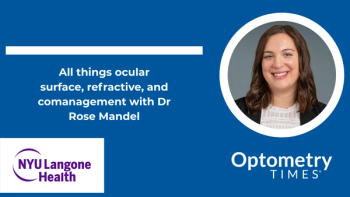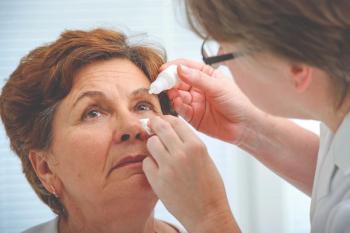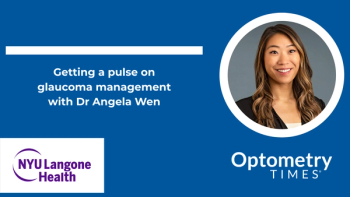
Glaucoma diagnosis, treatment proves to be a balancing act
Diagnosing glaucoma and deciding when, and whether, to begin treatment is not clear-cut. The patient's history, a comprehensive eye examination, and a diagnostic work-up can help in the decision process.
Key Points
New York-Glaucoma is unique compared with other ocular diseases because the diagnosis and the decision of when-or even whether-to begin treatment is not clear-cut, Mile Brujic, OD, told attendees at Vision Expo East in March.
"The unique thing is, someone can have [IOP] above the normal range, in the high 20s, and [it] still [can] be considered normal," said Dr. Brujic, a private practitioner in Bowling Green, OH. "Others can be in the normal range but still have significant vision loss."
Three elements
"It's really a balancing act pending on a lot of the information that we collect," he said.
The history portion of the process, Dr. Brujic said, should include collecting information about the family health history and the patient's medical conditions. It also should include learning of any medications taken by the patient, he added, because some drugs, such as steroids, may cause IOP to increase, and others drugs, such as beta blockers, may lower IOP-facts that may further complicate the decision of whether to initiate treatment.
The comprehensive eye exam portion of the process, he continued, should consist of anterior segment and optic nerve head evaluations. The practitioner should be aware of pigment present on the corneal endothelium, narrow angles, and pseudoexfoliative deposits that, if present, will be visible on the anterior capsule of the lens after the pupil has been dilated.
A systematic approach for evaluating the optic nerve, Dr. Brujic said, should involve assessment of the optic disc size (because larger optic nerves tend to have large cups), neuroretinal rim, and retinal nerve fiber layer (RNFL); examination for the presence of peripapillary atrophy; and determination of whether retinal or optic disc hemorrhages are present.1
"The most important tool[s] we have as practitioners in terms of monitoring and guiding our patients are observation and good clinical judgment," he said.
The third element, the diagnostic work-up, should include imaging of the optic nerve head as well as the performance of threshold visual field tests and pachymetry, Dr. Brujic said.
Advances in imaging technology-namely, scanning laser polarimetry, optic nerve head topography, and optical coherence tomography (OCT)-allow clinicians to obtain more information and to measure the thickness of the RNFL and other intricacies of the optic nerve, he said. Spectral-domain OCT is the most significant advance in imaging technology in recent years because it offers "more information in less time," he said.
Threshold visual field testing remains the standard of care, although significant subjectivity exists in patient responses.
"But that's still the closest thing to measuring how functional the patient will be," Dr. Brujic said. "If I have a patient I [suspect may have glaucoma], I have a certain level of confidence if they still have a full visual field, because they're still functional. I have certainly become more aggressive in initiating therapy if I see structural changes, either by physical examination of the optic nerve head or through changes seen utilizing imaging technologies."
Regarding pachymetry, he said, the Ocular Hypertension Treatment Study (OHTS) found that glaucoma does not develop as readily in patients who have ocular hypertension and central corneal thickness > 588 µm as it does in those with cornea thickness < 555 µm.2
"It is important, from a clinician's standpoint, to understand that thinner corneas seem to be associated with the greater risk," he said.
The next step
The next step in managing the care of the patient is to gather and review all of the collected information and then either begin treatment or choose to monitor the patient.
OHTS offers standards for determining when to begin treatment. This large-scale, multicenter study investigated the value of treating patients who have ocular hypertension but not glaucoma.3
The study enrolled 1,636 patients whose IOP measured 24 mm Hg to 32 mm Hg in one eye and 21 mm Hg to 32 mm Hg in the fellow eye. The patients' eyes showed no evidence of glaucomatous damage.
Patients were randomly assigned to observation alone or to treatment with commercially available topical ocular hypotensive medications. The goal of treatment was attainment of IOP of < 24 mm Hg and at least a 20% reduction from baseline. Outcome measures were a reproducible defect on 30–2 visual field testing and clinically significant reproducible optic disc deterioration due to primary open-angle glaucoma (POAG).
In the observation-only group, POAG developed in 9.5% of patients, whereas POAG developed in 4.4% of patients in the treatment group. After a median follow-up of 72 months, an almost 60% reduction in IOP was seen in treatment group.
Tools available
Several tools, including risk calculators, have emerged using information obtained from OHTS. For example, Dr. Brujic said he uses one available from Devers Eye Institute in Portland, OR, at
The treatment of patients who have IOP of ≥ 24 mm Hg and ≥ 2% annual risk of the development of glaucoma is likely to be cost-effective, according to the OHTS investigators, Dr. Brujic said.4
References
1. Fingeret M, Medeiros FA, Susanna R Jr, Weinreb RN. Five rules to evaluate the optic disc and retinal nerve fiber layer for glaucoma. Optometry. 2005;76:661-668.
2. Kass MA, Heuer DK, Higginbotham EJ, et al. The Ocular Hypertension Treatment Study: a randomized trial determines that topical ocular hypotensive medication delays or prevents the onset of primary open-angle glaucoma. Arch Ophthalmol. 2002;120:701-713; discussion 829-830.
3. Gordon MO, Beiser JA, Brandt JD, et al. The Ocular Hypertension Treatment Study: baseline factors that predict the onset of primary open-angle glaucoma. Arch Ophthalmol. 2002;120:714–720; discussion 829-830.
4. Kymes SM, Kass MA, Anderson DR, Miller JP, Gordon MO; Ocular Hypertension Treatment Study Group. Management of ocular hypertension: a cost-effectiveness approach from the Ocular Hypertension Treatment Study. Am J Ophthalmol. 2006;141:997-1008.
Newsletter
Want more insights like this? Subscribe to Optometry Times and get clinical pearls and practice tips delivered straight to your inbox.



















































.png)


